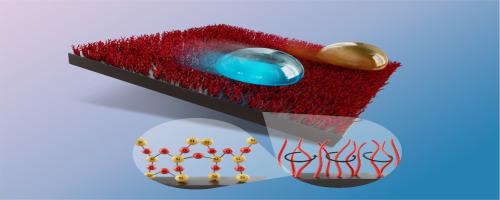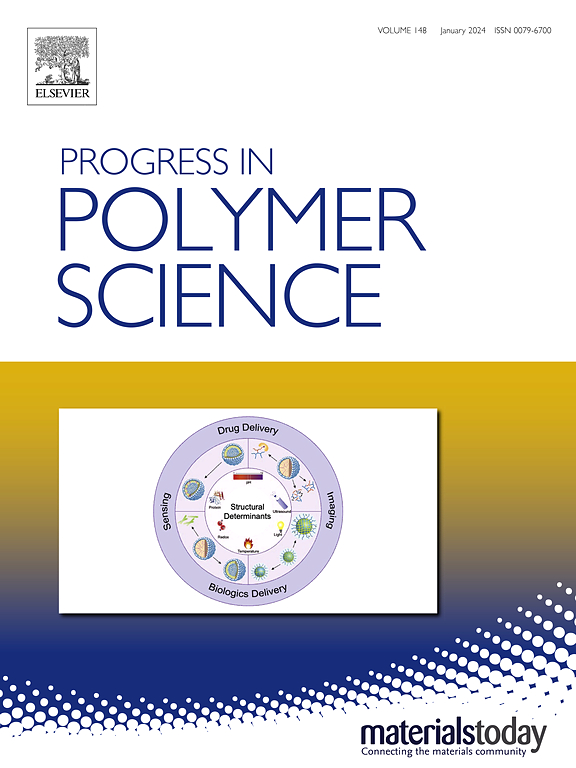自润滑,液体状的全憎聚合物刷:提高流体和固体控制的进展和策略
IF 26.1
1区 化学
Q1 POLYMER SCIENCE
引用次数: 0
摘要
在基础研究和实际应用中,对液体和固体具有更广泛抵抗力的表面引起了越来越多的关注。随着接枝聚合技术的发展和突破,具有极低玻璃化转变温度(约 -100 °C)的柔性聚合物链可以很容易地粘附在光滑的基底上,制成自润滑的全疏共价液体(SOCALs)。SOCALs 是一种新兴表面,通过弯曲和旋转运动显示出分子级聚合物链的界面流动性。它们在滑动多种液体时表现出前所未有的动态流动性,而不受表面张力的影响。其优异的滑动性使其处于表面科学、材料科学和生物学等领域的前沿。了解 SOCALs 的基本原理对于利用它们的特性提高工程系统的性能至关重要。本综述旨在全面概述 SOCALs 的最新发展,剖析这些材料表面去湿的基本原理。然后探讨 SOCALs 的设计配置,以及表面密度、分子量和结构等链的物理特性如何影响其界面流动性和动态液态质量。最后,报告重点介绍了 SOCAL 涂层材料在现实世界中的代表性应用,强调了将 SOCAL 材料作为材料和结构设计取得根本性进步的渠道的探索,在材料和界面创新之间架起了一座桥梁。本文章由计算机程序翻译,如有差异,请以英文原文为准。


Self-lubricated, liquid-like omniphobic polymer brushes: Advances and strategies for enhanced fluid and solid control
Surfaces with broader resistance to liquids and solids elicited increased interest in both fundamental research and practical applications. With the technological development and breakthroughs on graft polymerization, flexible polymer chains with extremely low glass transition temperatures (around −100 °C) can be easily affixed on a smooth substrate to make self-lubricated omniphobic covalently attached liquids (SOCALs). SOCALs are emerging surfaces displaying interfacial mobility of molecular-level polymer chains through bending and rotational motions. They have shown unprecedented dynamic fluidity in sliding multiple liquids irrespective of their surface tensions. Their exceptional slipperiness has positioned them at the forefront of fields such as surface science, materials science, and biology. Understanding the underlying principles of SOCALs is crucial for harnessing their features to improve the performance of engineering systems. This review aims to comprehensively overview state-of-the-art developments of SOCALs, dissecting fundamental principles that govern surface de-wetting on these materials. It then examines the design configuration of SOCALs and how the physical characteristics of chains such as surface density, molecular weight, and structure influence their interface mobility and dynamic liquid-like quality. Finally, it highlights representative applications of SOCAL-coated materials in real-world scenarios, emphasizing the exploration of SOCAL materials as a conduit for radical advancements in materials and structural design, bridging the gap between material and interface innovation.
求助全文
通过发布文献求助,成功后即可免费获取论文全文。
去求助
来源期刊

Progress in Polymer Science
化学-高分子科学
CiteScore
48.70
自引率
1.10%
发文量
54
审稿时长
38 days
期刊介绍:
Progress in Polymer Science is a journal that publishes state-of-the-art overview articles in the field of polymer science and engineering. These articles are written by internationally recognized authorities in the discipline, making it a valuable resource for staying up-to-date with the latest developments in this rapidly growing field.
The journal serves as a link between original articles, innovations published in patents, and the most current knowledge of technology. It covers a wide range of topics within the traditional fields of polymer science, including chemistry, physics, and engineering involving polymers. Additionally, it explores interdisciplinary developing fields such as functional and specialty polymers, biomaterials, polymers in drug delivery, polymers in electronic applications, composites, conducting polymers, liquid crystalline materials, and the interphases between polymers and ceramics. The journal also highlights new fabrication techniques that are making significant contributions to the field.
The subject areas covered by Progress in Polymer Science include biomaterials, materials chemistry, organic chemistry, polymers and plastics, surfaces, coatings and films, and nanotechnology. The journal is indexed and abstracted in various databases, including Materials Science Citation Index, Chemical Abstracts, Engineering Index, Current Contents, FIZ Karlsruhe, Scopus, and INSPEC.
 求助内容:
求助内容: 应助结果提醒方式:
应助结果提醒方式:


